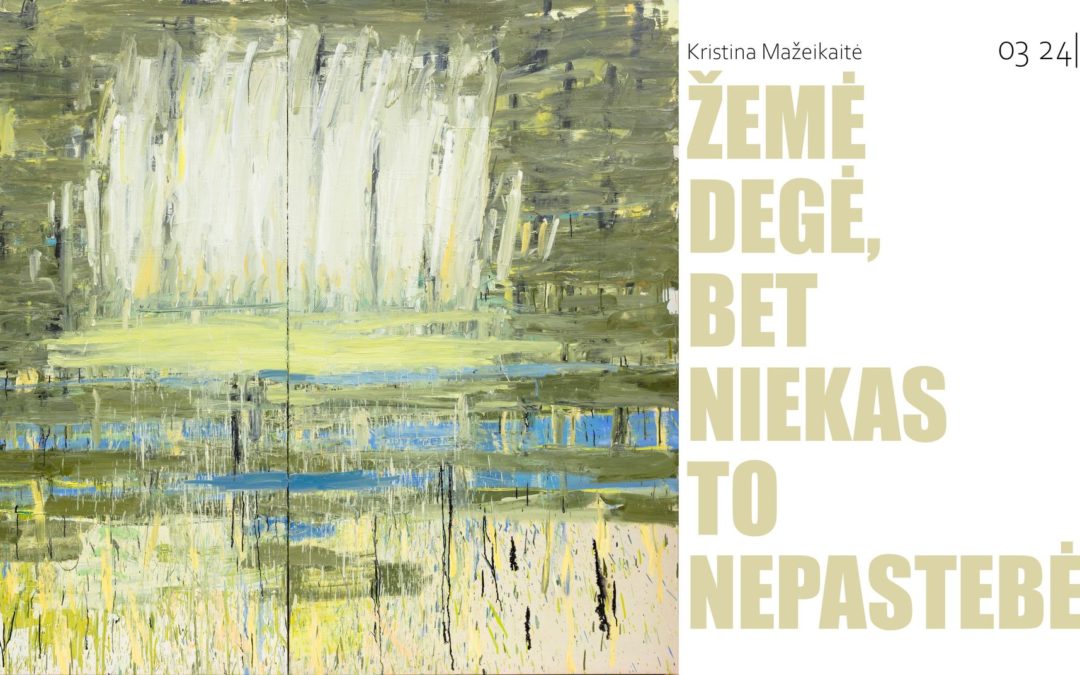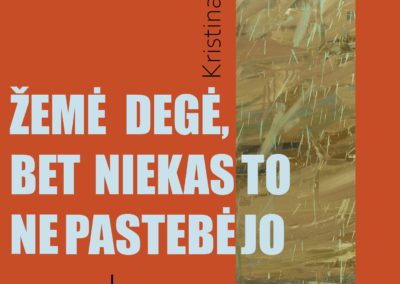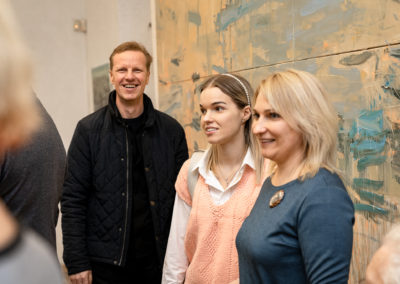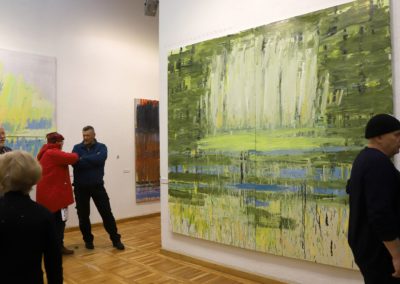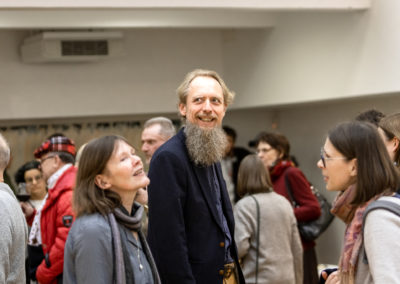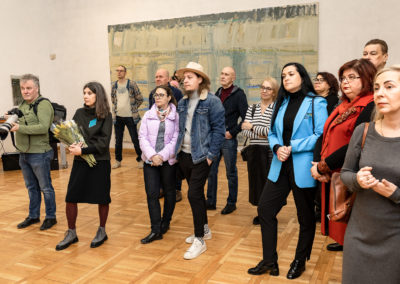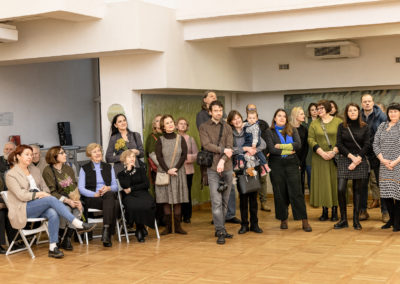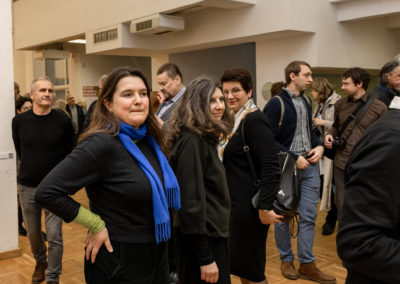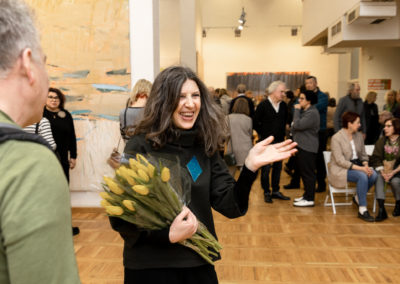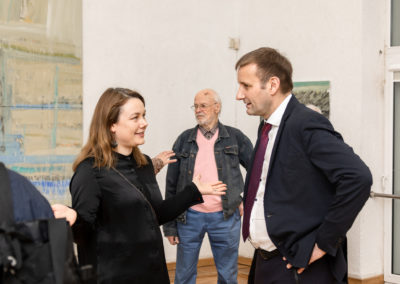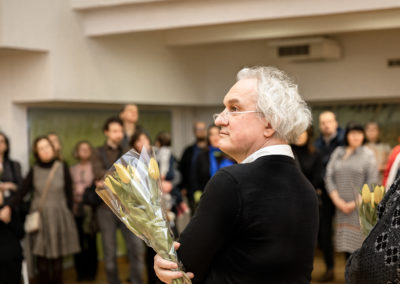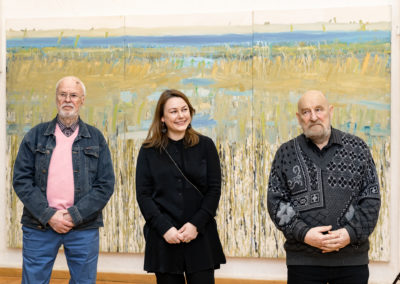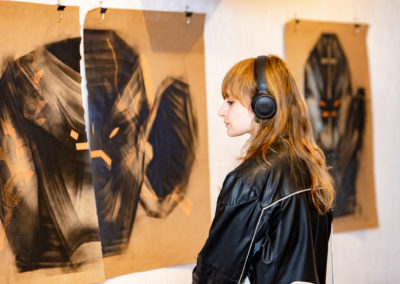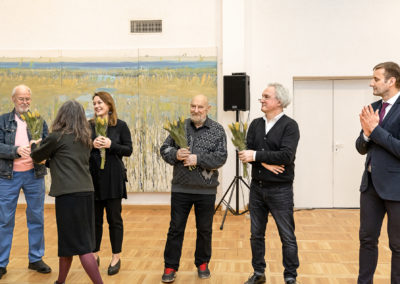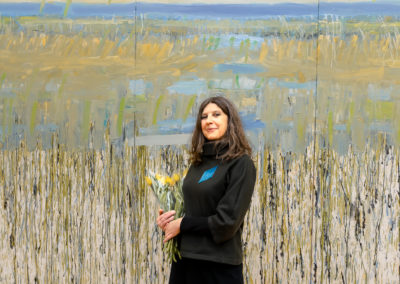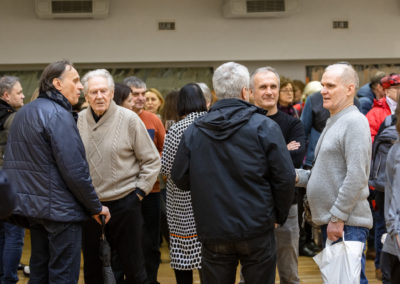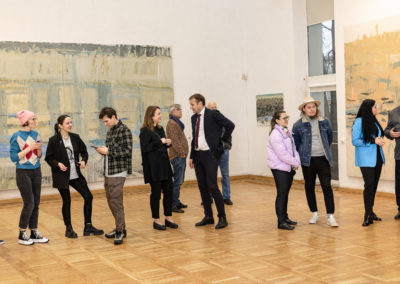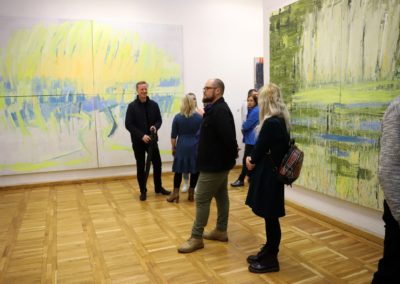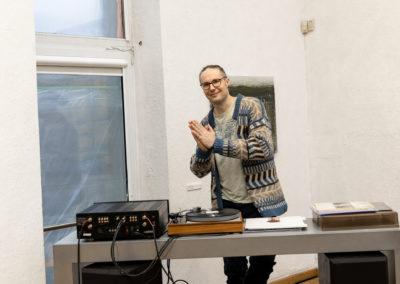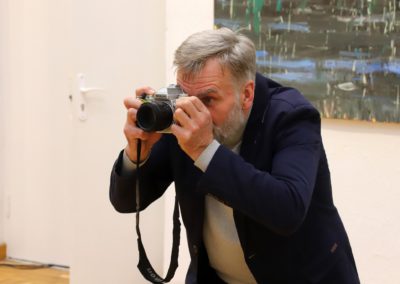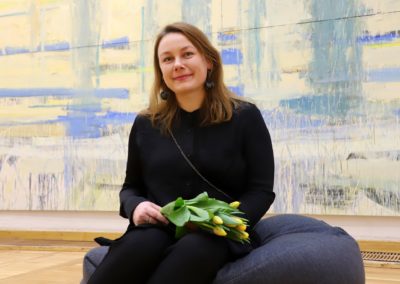2023 m. kovo 24 d., penktadienį, 17.00 val. Šiaulių dailės galerijoje atidaroma tapytojos Kristinos Mažeikaitės paroda „Žemė degė, bet niekas to nepastebėjo“. Paroda veiks iki balandžio 15 d.
ŽEMĖ DEGĖ, BET NIEKAS TO NEPASTEBĖJO
Man įdomu tapyti žemę. Sukurti žemę. Ir dar įdomiau joje įtapyti šviesą. Šviečianti žemė! Šis paradoksas mane ypač „pagavo“ 2018 m., kuomet pristačiau ciklą „Degančios saulės namai“. Tačiau tuose paveiksluose dangaus buvo nedaug, o švietė žemė. Žemė, kuri tarsi skleidė per amžius suakumuliuotą saulės energiją.
2022-aisiais, žiemą, man iš minties niekaip neišėjo „degančios žemės“ motyvas. Radosi darbai „žemė degė, bet niekas to nepastebėjo“. Atrodytų, kad jei tapoma deganti žemė, turėtų aplink svilti nuodėguliai, o paveiksluose lietis raudonos liepsnos. Bet man tai atrodė per paprasta. Manoji deganti žemė buvo tyli, kantri ir susikaupusi. Šviečianti tarsi pati iš savęs. Su aliuzijomis į renesanso meistrų tapybą, atkartojanti jų koloritą ar atskirus fragmentus.
Šiuose paveiksluose nebuvo žmogaus. Žmogaus mastelis buvo tarsi per smulkus, į peizažą žiūrėta per pasaulio sandaros prizmę. O tapant paveikslus bandyta įsijausti į žemės sluoksnių persidengimus, požeminius vandens šaltinius ar lėtą litosferų judėjimą. Kita vertus, atskiruose paveiksluose galima justi žmogaus žvilgsnį į peizažą, į tolimą jo horizonto liniją, žvilgsnį tarsi tikintis kažko, kas būtų atrasta anapus horizonto linijos, bet kartu suprantant, kaip tai neįmanoma.
Sukūriau visą seriją „degančios žemės“ tema. Paskui prasidėjo karas ir kurį laiką netapiau.
Man taip pat įdomu per savo kūrybą spręsti kūrėjo klausimą. Kokia jo vieta? Ką gali kūrėjas? Kokios kūrybos galimybės? Ką dar galima sukurti? Tad „deganti žemė“ – tai ir kūrėjo metafora, kūrėjo egzistencijos išgyvenimas bei santykio su auditorija išraiška.
Žemės/ peizažo motyvo studija ir kūrėjo egzistencijos permąstymas tampa kertiniais parodos raktažodžiais. O kūrybos procese tai darniai susilieja į vieną – į kūrėjo gyvenimo patirtį.
***
Mano kūryboje dominuoja transformacijos principas, kai pirminis vaizdas yra perkuriamas, transformuojamas, vizijai realizuoti. Mano tapybai taip pat didelį poveikį yra padaręs domėjimasis architektūra. Paveikslai tarsi konstruojami, „statomi“ iš skirtingų potėpių, linijų, dėmių, pasitelkiant griežtus komponavimo principus, Gilles Deleuze žodžiais tariant, iš pradinio chaoso įvedama griežta, struktūruota tvarka. Ne kartą esu girdėjus mano paveikslus apibūdinant kaip architektūriškus. Manau, tokį pojūtį lemia ir tai, kad nors mano tapyba ekspresyvi, gestinė, joje nėra atsitiktinio proveržio, neapgalvotos konvulsijos. Kiekvienas potėpis turi savo vietą. Architektūros principai atsispindi ir parodos eksponavime, kur ypatingas dėmesys skiriamas į tai, kaip žiūrovas vaikščios po erdvę, koks pojūtis bus kuriamas, kokie vizualiniai ryšiai atsivers. Galiausiai, apibūdindama savo paveikslus pasitelkiu figuratyvumo sąvoką. Čia vėlgi perinterpretuoju Gilles Deleuze filosofiją ir figuratyvo sampratą, kurią jis apibūdina kaip grynai nenaratyvinę, išsivadavusią nuo bet kokių klišių. Figūros elementą aš sieju su visa drobe – paveikslas kaip figūra su taktilinėmis savybėmis. Paveikslas, kuris Tave traukia, slegia, primena.
Sujungus visus šiuos elementus, kuriamas daugiasluoksnis paveikslas, kur sugula ne tik dažų sluoksniai ar meno istorijos įtakos, bet ir atminties, patirties sluoksniai. Iš vienos pusės gali atrodyti, kad tai tik tapybos darbas, tik „gražus“ peizažas. Bet per suakumuliuotus spalvinius kodus ir tapybines raiškos priemones, ramus peizažo vaizdas gali savyje talpinti ir skaudžią atmintį. Taip asmeninės patirtys tampa bendromis. Čia nebėra vieno konkretaus peizažo, nebėra vienos konkrečios lokacijos. Tai yra tik visi Tavo kada nors patirti peizažai, ir laikas, tekėjęs pro juos.
APIE MENININKĘ:
Kristina Mažeikaitė (g. 1987,Vilniuje) – menininkė, tapytoja. Tapydama ji eksperimentuoja su mega formato drobėmis ir tapybinėmis raiškos teikiamomis galimybėmis. Pasitelkdama abstrahuotą raišką ir atsisakydama naratyvinio vaizdo, autorė nagrinėja žemės sandaros struktūras, laiko tėkmės, egzistencinės būties patirtis. Jungdama koncepciją su tapybine forma, paveikslais kuria taktilines patirtis. Todėl kiekvienos parodos architektūra – tai įtrauki paveikslų instaliacija. Tapytoja 2015 metais baigė Vilniaus dailės akademiją, tapybos magistrantūrą; 2014 m. pelnė Ary Stillman vardo stipendiją. Kūriniai eksponuoti individualiose parodose: „Gates to the Garden“ (Vilniaus rotušė, 2023), „Niekieno žemė“ (galerija „Arka“, 2021), „Saudade“ (Antano Mončio namai-muziejus, 2021), „Degančios saulės namai“ (Pamėnkalnio galerija, 2018), „Rojaus obuoliukai“ (Šv. Jono gatvės galerija, 2018), „Tapytojo peizažas“ (Energetikos ir technikos muziejus, 2016) ir kt.
In 2023 March 24, 5:00 p.m. the exhibition of the painter Kristina Mažeikaitė „The Earth was burning, but no one noticed” opens in the Šiauliai art gallery. The exhibition will be open until April 15.
THE EARTH WAS BURNING, BUT NO ONE NOTICED
I am interested in painting the earth. Create land. And it is even more interesting to add light to it. Shining Earth! This paradox especially „caught” me in 2018, when I presented the series „House of the Burning Sun”. However, in those paintings there was little sky, and the earth shone. An earth that seemed to emit solar energy accumulated over the ages.
In the winter of 2022, the motif of the „burning earth” never left my mind. Works found „the earth was burning, but no one noticed.” It would seem that if it becomes a burning earth, there should be scum around it, and red flames should rain down on the paintings. But it seemed too simple to me. My burning earth was quiet, patient and collected. Shining as if by itself. With allusions to the painting of Renaissance masters, reproducing their color or individual fragments.
There was no human in these paintings. The human scale was as if too small, the landscape was viewed through the prism of the structure of the world. And when painting pictures, we tried to get into the overlaps of the earth’s layers, underground water sources or the slow movement of the lithosphere. On the other hand, in individual paintings, one can feel a person’s gaze at the landscape, at its distant horizon line, a gaze as if hoping for something that would be discovered beyond the horizon line, but at the same time understanding how impossible it is.
I created a whole series on the theme of „burning earth”. Then the war started and I didn’t paint for a while.
I am also interested in solving the question of the creator through my work. What is its location? What can a developer do? What are the creative possibilities? What else can be created? Therefore, „burning earth” is also a metaphor for the creator, an experience of the creator’s existence and an expression of the relationship with the audience.
The study of the land/landscape motif and the rethinking of the creator’s existence become the key keywords of the exhibition. And in the creative process, it harmoniously merges into one – the creator’s life experience.
***
The principle of transformation dominates my work, when the original image is recreated, transformed, to realize the vision. My painting is also greatly influenced by my interest in architecture. The paintings are as if constructed, „built” from different strokes, lines, spots, using strict principles of composition, in the words of Gilles Deleuze, a strict, structured order is introduced from the initial chaos. More than once I have heard my paintings described as architectural. I think this feeling is also determined by the fact that although my painting is expressive, gestural, there is no random breakthrough or thoughtless convulsion in it. Every stroke has its place. The principles of architecture are also reflected in the display of the exhibition, where special attention is paid to how the viewer will walk around the space, what sensation will be created, what visual connections will open. Finally, I use the concept of figurativeness to describe my paintings. Here again, I reinterpret Gilles Deleuze’s philosophy and the concept of the figurative, which he describes as purely non-narrative, freed from any clichés. I associate the element of the figure with the whole canvas – the painting as a figure with tactile qualities. A picture that attracts you, depresses you, reminds you.
By combining all these elements, a multi-layered painting is created, where not only the layers of paint or the influence of art history, but also the layers of memory and experience. On the one hand, it may seem that this is just a work of painting, just a „beautiful” landscape. But through the accumulated color codes and pictorial means of expression, a calm landscape image can also contain a painful memory. This is how personal experiences become shared. There is no longer one specific landscape, no longer one specific location. These are just all the landscapes you’ve ever experienced, and the time that passed through them.
ABOUT THE ARTIST:
Kristina Mažeikaitė (b. 1987, Vilnius) – artist, painter. While painting, she experiments with mega-format canvases and the possibilities of pictorial expression. Using an abstract expression and abandoning the narrative image, the author examines the structures of the earth’s structure, the flow of time, the experience of existential being. By combining the concept with the pictorial form, the paintings create tactile experiences. Therefore, the architecture of each exhibition is an immersive installation of paintings. In 2015, the painter graduated from Vilnius Academy of Fine Arts, master’s degree in painting; in 2014 earned the Ary Stillman Scholarship. Works exhibited in individual exhibitions: „Gates to the Garden” (Vilnius Town Hall, 2023), „No Man’s Land” („Arka” Gallery, 2021), „Saudade” (Antanas Mončis House-Museum, 2021), „House of the Burning Sun” ( Pamėnkalnis Gallery, 2018), „Paradise Apples” (St. John Street Gallery, 2018), „Painter’s Landscape” (Museum of Energy and Technology, 2016) and others.

